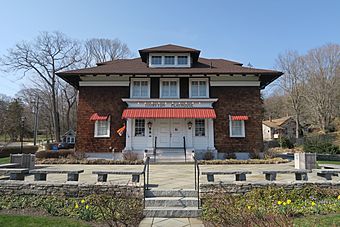Ivoryton, Connecticut facts for kids
Quick facts for kids |
|
|
Ivoryton Historic District
|
|

Ivoryton Playhouse
|
|
| Location | Roughly bounded by Main Street, North Main Street, Oak Street, Blake Street, Summit Street, Park Road, and Comstock Avenue, Ivoryton, Essex, Connecticut |
|---|---|
| Built | Various |
| Architectural style | Various |
| NRHP reference No. | 13000895 |
| Added to NRHP | April 15, 2015 |
Ivoryton is a cool village located in Essex, Connecticut. It's one of three villages in this area. The Ivoryton Historic District is a special part of Ivoryton. It was added to the National Register of Historic Places on April 15, 2014. This means it's an important place with a lot of history!
You can find the famous Ivoryton Playhouse inside this historic district. The playhouse is also listed on the National Register.
Contents
Discovering the Ivoryton Historic District
The Ivoryton Historic District covers an area roughly bordered by several streets. These include Main Street, North Main Street, Oak Street, Blake Street, Summit Street, Park Road, and Comstock Avenue. This area is known as a great example of a "company town" from the 1800s. It was also once a major center for the ivory industry around the world.
What is a Company Town?
A company town is a place where a single company owns most of the homes and stores. It also employs most of the people. These towns were built around factories or mines. They provided housing and services for workers and their families. Ivoryton is a good example of this type of community.
Ivory Industry in Ivoryton
The area became important for industry when Comstock, Cheney & Company started here. This company was founded in the 1860s by Samuel Merritt Comstock and George A. Cheney. They were in the business of importing ivory.
Ivoryton was one of many industrial areas in the Connecticut River Valley. These areas grew a lot in the late 1800s. Ivoryton was also a special place for immigrants. Many people from Sweden, Germany, Italy, and Poland came to live and work here. They lived in special housing built for workers throughout the village.
Pratt, Read & Company was another big ivory maker nearby. Together, these two companies were the largest ivory manufacturers in America. They had a huge share of all ivory production in the United States.
The area was very successful between 1860 and 1938. At its busiest, Ivoryton employed and housed up to 600 workers.
Buildings and History of the District
The National Register of Historic Places describes the district well. It includes very old Colonial buildings. These show what the village was like before it became an industrial hub. There are also buildings from the mid-to-late 1800s. These were used for processing and making ivory products.
You can also see fancy Victorian homes where company leaders lived. There are also simpler, everyday homes and apartments for factory workers. Public buildings like churches, a post office, a company store, a library, and a town meeting hall are also part of the district.
Some factory buildings are gone today. Also, the special "bleach houses" used in the ivory industry are no longer there. Many houses have been updated, and the village was damaged in a flood in 1982.
However, Ivoryton still looks much like it did in the past. It's a great example of a planned community. It shows how a unique industry shaped a town in the Connecticut River Valley. The important historical period for Ivoryton goes from about 1719 to 1938. The oldest building still standing is the Joseph Parker Homestead, built around 1719. The period ends in 1938, when the company sold off its worker housing.



